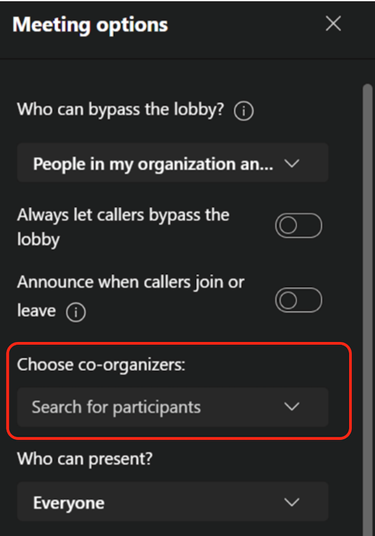1 Overview of Microsoft Teams meeting Roles
If you’re organizing a meeting with multiple attendees, you may want to assign roles to each participant to determine who can do what in the meeting.
There are three roles to choose from: co-organizer, presenter, and attendee. Co-organizers and presenters share most organizer permissions, while attendees are more controlled.
2 Capabilities of each Teams role
| Capability | Organizer | Co-organizer | Presenter | Attendee |
| Speak and share video | ||||
| Participate in meeting chat | ||||
| Share content | ||||
| Privately view a PowerPoint file shared by someone else | ||||
| Take control of someone else’s PowerPoint presentation | ||||
| Mute other participants | ||||
| Prevent attendees from unmuting themselves | ||||
| Remove participants | ||||
| Admit people from the lobby | ||||
| Change the roles of other participants | ||||
| Start or stop recording | ||||
| Start or stop live transcription | ||||
| Manage breakout rooms | ||||
| Change meeting options | ||||
| Add or remove an app | ||||
| Use an app* | ||||
| Change app settings |
*Some apps may limit what certain roles can do.
3 Change Team meeting roles
3.1 Before a Team meeting
You’ll need to send out the meeting invite before you can assign roles.
Once you’ve done that, go to Calendar , double-click the meeting you just created, and select Meeting options .
This will bring you to a web page, where you’ll see Choose co-organizers and the following choices under Who can present?
| Who can present? | What happens |
| Everyone | Anyone who has access to the meeting link will join the meeting as a presenter. |
| People in my organization | Only people in your org will be presenters. External participants will join as attendees. |
| Specific people | Only the people you choose from the list of invitees will be presenters. Everyone else will join as attendees. |
| Only me | Only the organizer will be a presenter. All other participants will join as attendees. |
3.1.1 A couple of things to keep in mind:
- You’ll need to send your meeting invite directly to anyone you want to select as a presenter.
- Co-organizers can’t make changes to a meeting before it starts.
- The role of the meeting organizer can’t be changed.
Note: The ability to select specific presenters isn’t yet available for channel meetings.
3.2 During a Teams meeting
There are two ways for you or a co-organizer to change someone’s role while a meeting is in progress:
- Go to Calendar
 ,double-click the meeting, and select Meeting options . Use the drop down menu for Choose co-organizersto add a co-organizer. The co-organizer(s) you assign will then receive a notification stating they can share content and facilitate the meeting.
,double-click the meeting, and select Meeting options . Use the drop down menu for Choose co-organizersto add a co-organizer. The co-organizer(s) you assign will then receive a notification stating they can share content and facilitate the meeting.
Note: If the meeting is recurring, any change you make in Meeting optionswill apply to all meeting occurrences.
- Select Show participants in the meeting controls to see a list of all the people in the meeting. Hover over the name of the person whose role you want to change and select More options. From there, select Make a presenter or make an attendee.
Notes:
a. If the meeting is recurring, role assignments made in this way will only apply to the current meeting. For future occurrences, participants will keep the role assigned to them on the Meeting options page.
b. If someone exits the meeting and then rejoins it later, they’ll rejoin with the last role they were assigned.
